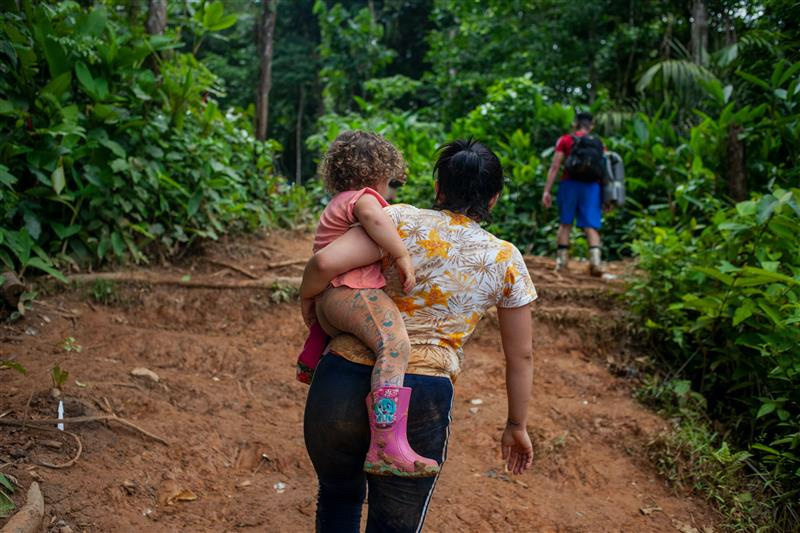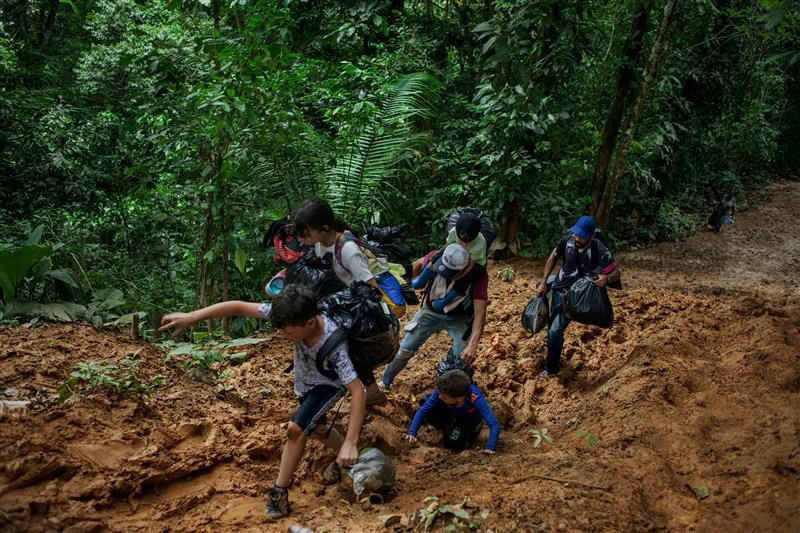
ANASTASIA MOLONEY, of Thomson Reuters Foundation, reports from migrant routes passing through the Darien Gap between Colombia and Panama…
Capurgana, Colombia
Thomson Reuters Foundation
Five-months pregnant and lugging a heavy backpack through a lawless stretch of Colombian rainforest, a migrant woman from Angola says “no” for a second time to the jungle porter offering to carry her bag for $US20.
“It’ll get harder, more mountains ahead,” the burly local man warns her at the start of the 96 kilometres trek through the wilderness to neighbouring Panama. But she shakes her head and trudges forward along the steep muddy path.

A family of Venezuelan migrants with young children walk through the Colombian jungle in the Darien Gap on day one of a five-to seven-day perilous and exhausting trek through the Darien Gap, Colombia, on 27th July. PICTURE: Thomson Reuters Foundation/Fabio Cuttica
In front of them and behind, a straggly column of dozens of men, women and children weaves its way into the Darien Gap – a perilous jungle route without roads that is being used by record numbers of migrants determined to reach the United States.
Some hold babies and toddlers, others machetes to defend themselves from snakes, but many are poorly equipped for the days-long trek during which at least 51 migrants died or disappeared last year, according to the UN migration agency.
“I’m looking for greener pastures. A better life. I’ve been told the road isn’t easy.”
– Abdu, a 24-year-old agriculture student from Ghana
Among the group are two brothers from a Nepalese farming family. Using their small plot of land as security, their parents raised a $US6,000 loan to pay for the brothers’ journey in search of work.
There are also destitute Venezuelans fleeing years of political and economic chaos, a former Congolese boxing champion and young men driven from their homes by conflict in Cameroon and the Taliban’s return to power in Afghanistan.
A record 133,000 people crossed the Darien Gap last year, including 29,000 children, according to Panamanian authorities.
This August alone, a record 32,000 migrants traversed the Darien, up 40-fold from the same month last year, according to Human Rights Watch.
Drenched in sweat and carrying a bag with a tent and canned food, Abdu, a 24-year-old agriculture student from Ghana, lived in Brazil for several years before deciding to head for the United States.
“I’m looking for greener pastures. A better life. I’ve been told the road isn’t easy,” said Abdu.
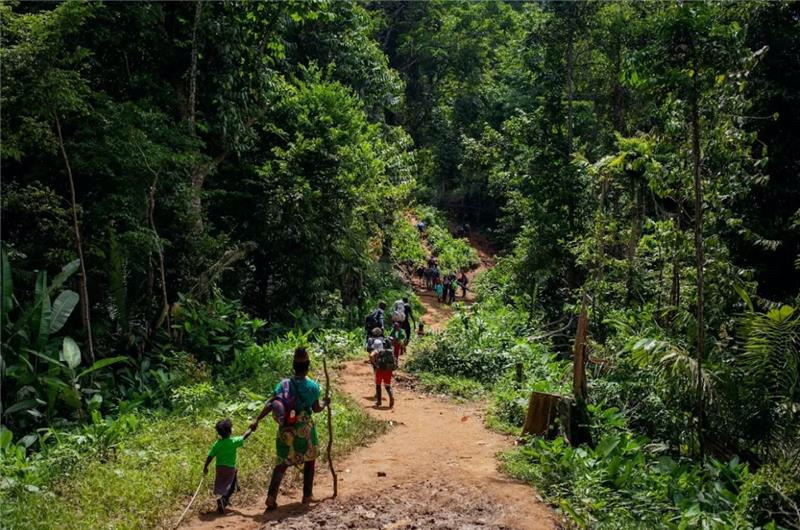
Migrants walk through the Colombian jungle on day one of a five-to seven-day perilous trek in the Darien Gap, Colombia, on 27th July. PICTURE: Thomson Reuters Foundation/Fabio Cuttica
Many migrants from Africa and Asia fly to Ecuador and Brazil where few visa restrictions allow an easy point of entry into the Americas. From there, they head north.
Venezuelans surpassed Cubans and Haitians as the largest national group making the crossing this year as new visa restrictions imposed by several Latin American countries make it harder for them to fly into Mexico and Central America. Some six million Venezuelans have fled their homeland since 2014.
With rising inflation and unemployment in Latin America and hopes that US President Joe Biden will grant more Venezuelans Temporary Protected Status or asylum, many Venezuelans are on the move again.
Wilbar, 19, who was travelling without a passport and had $US90 stashed in his Bible, left Venezuela when he was 15 and has been working on construction sites in Colombia since then.
To pay for the journey, he slept rough for several weeks to save on rent and camped on the beach in the Colombian beach town of Necocli – a gateway to the Darien – where he earned $US30 recycling plastic and cardboard for a few days.
“There are better opportunities in the United States…My goal is to buy my mother and sister a house in Venezuela,” said Wilbar, his small backpack wrapped in plastic to protect it from the humidity and frequent downpours in the forest.
Like many migrants, Wilbar has seen videos on TikTok of the treacherous journey showing migrants lying exhausted in the mud, or of children nearly swept away by the current of crocodile-infested rivers.
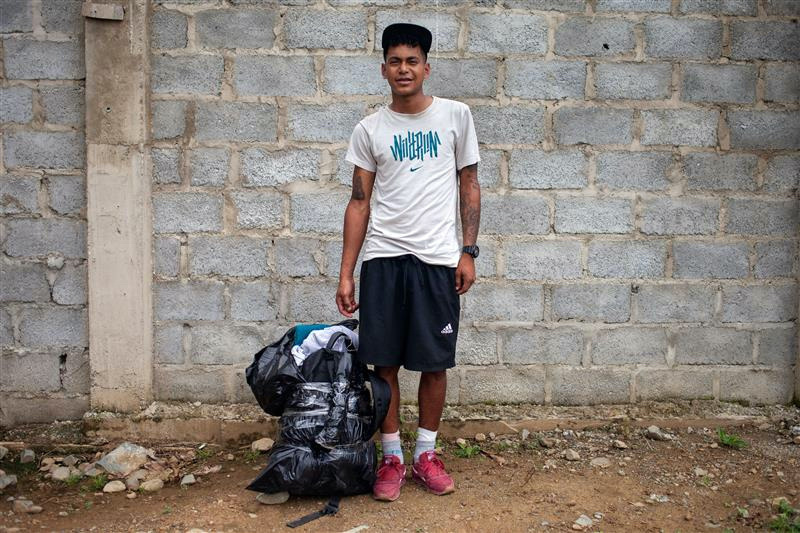
Wilbar, a 19-year-old Venezuelan migrant travelling with a group of Venezuelan families, at a camping site in the Colombian town of Capurganá, standing next to his backpack wrapped with plastic to protect it from the rain before starting the jungle trek through the Darién Gap. Capurganá, Colombia, on 27th July. PICTURE: Thomson Reuters Foundation/Fabio Cuttica
Even for the relatively young and fit, the trek is an endurance test.
Less than an hour in, people weighed down by heavy loads and six-litre water bottles were already struggling and needed frequent breaks.
Bags are made lighter. Clothes, shoes, and non-essential luggage are left behind, littering the forest floor.
We rely on our readers to fund Sight's work - become a financial supporter today!
For more information, head to our Subscriber's page.
For Necocli and the nearby tourist town of Capurgana, a local economy replacing Colombian pesos with US dollars has flourished to cater to the hundreds of migrants who pass through every day.
In Necocli, migrants have overtaken tourists as the main driver of the local economy.
“We used to have to wait for the tourist season. Now we don’t have to as there are migrants all year round….migration will never end,” said hostel owner German Julio.
About 750 migrants on average a day passed through the town this year, said Wilfredo Menco, head of Necocli’s Ombudsman’s Office, a government human rights agency.
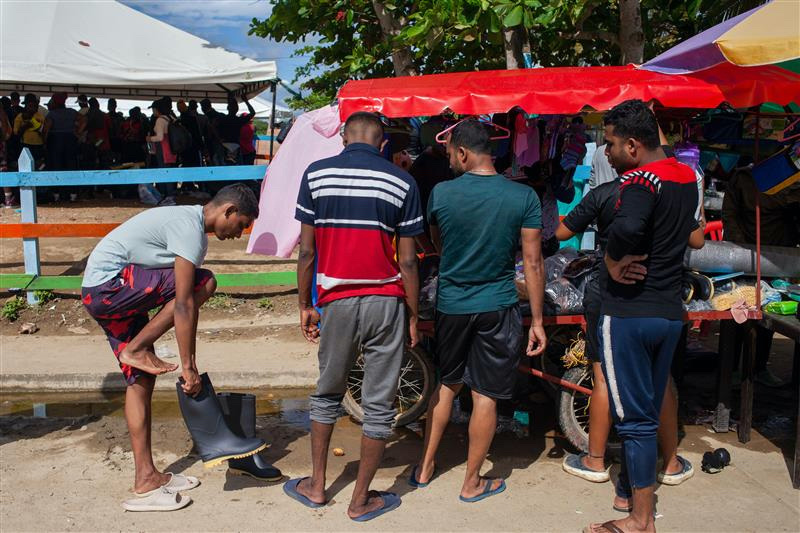
Migrants from Nepal try on rubber boots and buy jungle kit to prepare for the jungle trek through the Darién Gap in the Colombian beach town of Necoclí. Necoclí, Colombia, on 26th July. PICTURE: Thomson Reuters Foundation/Fabio Cuttica
Jungle guides and porters, boat companies, owners of hostels, restaurants and pharmacies, along with street vendors and money changers are all cashing in, often trading in dollars.
“Before I was a housewife and didn’t have a job,” said Graciela Leon, 63, who runs a stall along Necocli’s beach boardwalk selling machetes, tents, rubber boots and other jungle supplies.
The migrant route is a multi-million-dollar business and an increasingly lucrative sideline for the notorious Gulf Clan, Colombia’s largest and most powerful drug cartel, local people said, though most were reluctant to discuss the details.
The cartel controls who enters the Darien Gap and takes a cut on the earnings of most local businesses, including those serving the migrants.
“A share does go to the illegal groups,” said Menco.
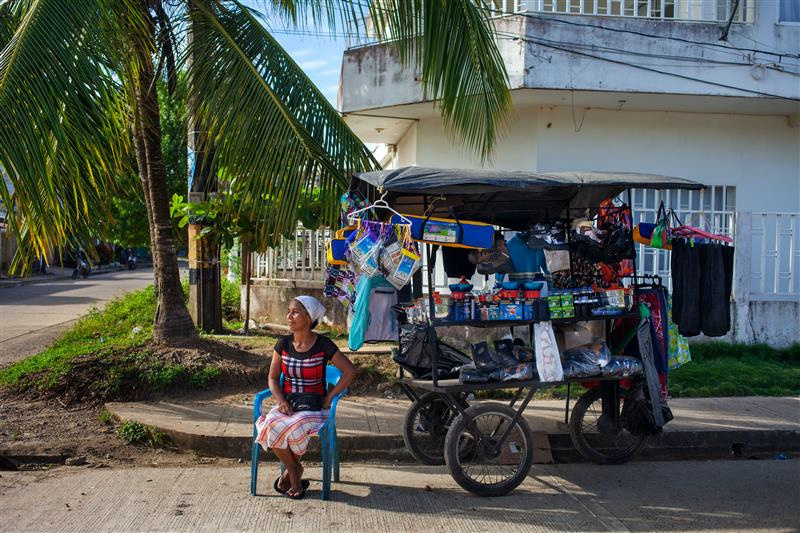
Street seller Graciela Leon sits next to her stall selling jungle kit to migrants in the Colombian beach town of Necoclí along the main beachfront promenade, on 29th July, PICTURE: Thomson Reuters Foundation/Fabio Cuttica
Asking not to be identified for fear of reprisals, several people said the cartel charged a 20 per cent protection tax, known locally as a “vacuna” or vaccine.
“Not a leaf moves without their permission,” said one aid worker who did not want to be named.
But state authorities are largely absent in the area and tend to allow migrants to pass through towards the Darien Gap.
From Necocli, migrants wearing life jackets wait in orderly lines to board the same comfortable boats used by tourists to cross the Gulf of Uraba. They pay $40 for a two-hour ride to reach Capurgana, from where the jungle trek begins.
Here, they hand over about $US160 each to be led through the jungle by organized teams of “guides” as the local people smugglers call themselves.
In Capurgana, where the jungle trek begins, elected community leader, Carlos Alberto Ballesteros, is in charge of 30 guides, who each lead groups of about 25 migrants.
He was at pains to highlight that migrants are not abused, dumped or harmed along the Darien.
“We want it to be recognised that we take care of migrants and that this isn’t human trafficking,” he said.
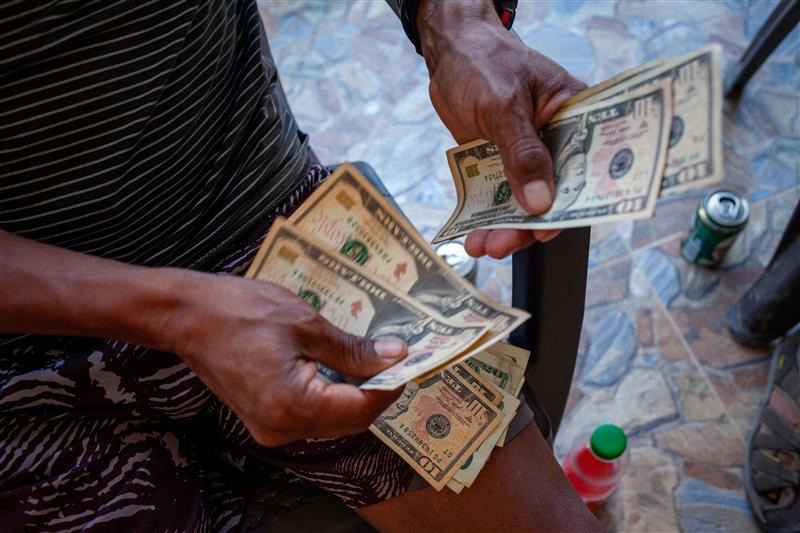
Colombian Carlos Alberto Ballesteros, an elected community and guide leader, hands out dollar bills to several Panamanian Indigenous leaders on the porch of his home in the Colombian town of Capurganá on 26th July. Indigenous leaders receive a share of guide fees for each migrant who passes through their territory. PICTURE: Thomson Reuters Foundation/Fabio Cuttica
Yet the United Nations and aid groups warn that many migrants experience extreme violence at the hands of armed bandits along the Darien crossing.
Medical charity Medecins Sans Frontieres, which runs two migrant reception centers in Panama, said 81 per cent of its patients seen from April, 2021, to June, 2022, had witnessed and or were victims of some type of violence along the journey.
During that period, MSF dealt with 456 sexual violence cases, including mass rapes involving groups of 10 to 15 men, said Marisol Quiceno, head of MSF’s humanitarian affairs.
“Migrants have told us they have seen people being killed along the way. They have had their money stolen, and even food, medicine and boots taken away,” said Quiceno.
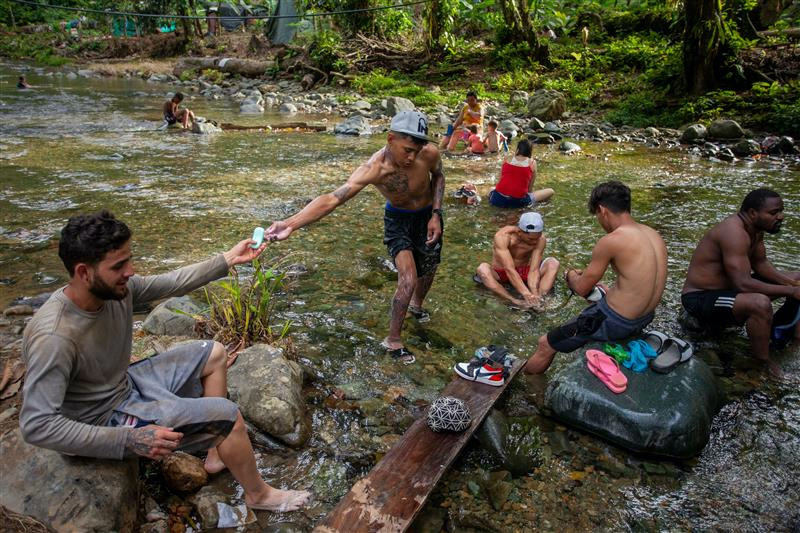
Migrants from Venezuela and African countries take a break and bathe in a stream at the first camping site after a day of trekking in the Colombian jungle in the Darién Gap, Colombia, on 27th July. PICTURE: Thomson Reuters Foundation/Fabio Cuttica
Back on the trail as dusk approached, at the first campsite, dozens of weary migrants pitched tents and lit camping stoves to cook while children splashed in a nearby river and others washed the mud from their arms, feet and legs.
“People say ‘how can you do this with children?’. But it’s more painful to leave our children behind in Venezuela,” said Macyuli, a migrant traveling with her four children and husband.
When they make it through the wall of jungle, migrants still face a journey of roughly 4,000 kilometres and five borders through Central America before they reach the toughest barrier of all – the US-Mexico border.
“We go with the hand of God. The lord is our guide,” Macyuli said, resting on the riverbank.
Below- Venezuelan migrant Macyuli, traveling with her four children and husband, and other Venezuelan families, walks along the jungle path through the Darién Gap carrying her daughter. Darién Gap, Colombia, on 27th July. PICTURE: Thomson Reuters Foundation/Fabio Cuttica.
